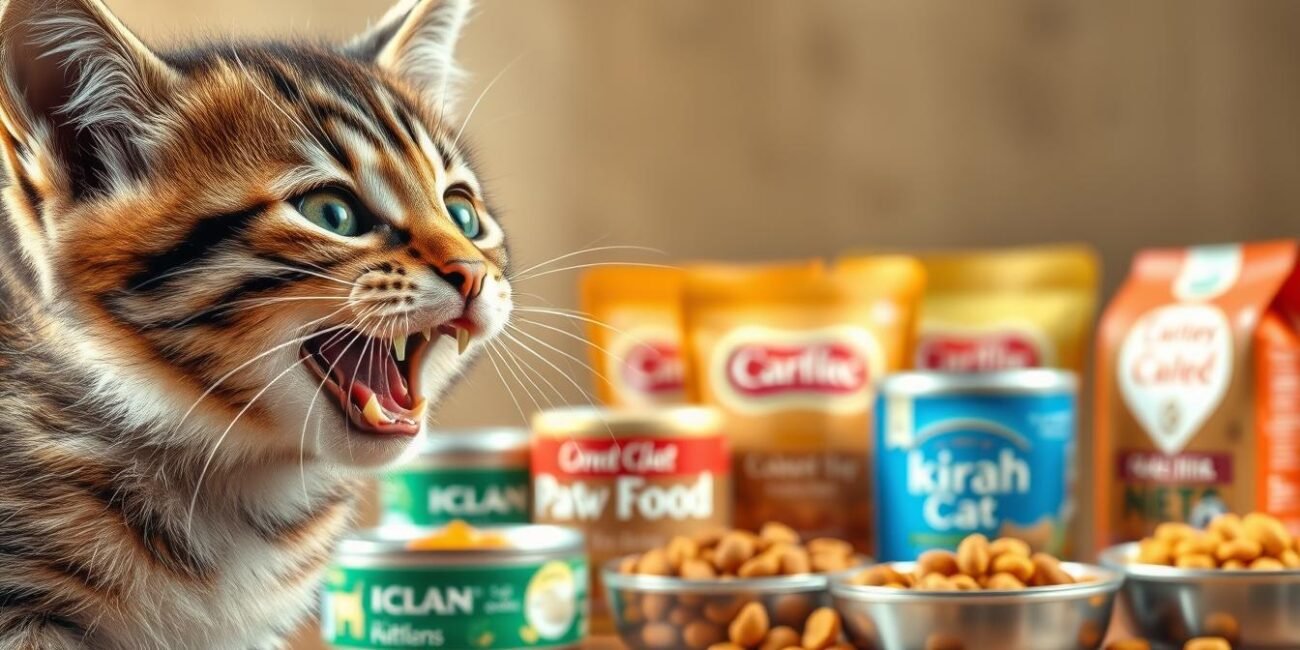Cat owners often get mixed advice on what to feed their pets. Some love the easy-to-eat kibble, while others worry about health risks. This makes many wonder: does kibble really fit what cats need, or could it hurt their health?
Today’s kibble has changed a lot. Many brands focus on high protein and extra vitamins. But, worries about low moisture and too many carbs still exist. Vets say that quality is more important than type—a good diet can be dry or wet.
Knowing what your cat needs is key. Things like age, how active they are, and any health issues affect their diet. We’ll look at science, expert views, and real stories to guide you in choosing the best for your cat.
Key Takeaways
- Hydration needs vary between cats and may influence food choices
- High-quality kibble can provide complete nutrition when formulated properly
- Dental health claims about crunchy food require closer examination
- Ingredient lists reveal more about nutritional value than food type alone
- Cost and convenience remain significant factors for many pet owners
- Combination feeding strategies are gaining veterinary support
Understanding Cat Nutrition Essentials
Cats are different from other pets because they need certain nutrients. As obligate carnivores, they get these nutrients mainly from animal proteins. Knowing what feline dietary needs are helps cat owners choose the right food.
The Role of Protein in a Cat’s Diet
Protein is crucial for cats. They need amino acids like taurine and arginine, found in meat. Without enough protein, cats may face:
- Muscle loss
- Weak immune systems
- Skin and coat problems
Cats need at least 26% protein in their diet. This is more for kittens or active cats. Plant-based proteins often don’t have all the amino acids cats need.
Importance of Moisture Intake
Wild cats get most of their water from their prey, which is very moist. Dry cat food has only 6–10% moisture. This means cats have to drink more water, which many struggle with.
Drinking enough water is key to avoid problems like:
- Urinary tract infections
- Kidney disease
- Digestive slowdowns
Adding water to kibble or using a pet fountain can help. But wet food or raw diets are closer to what cats naturally eat.
| Food Type | Moisture Content | Protein Quality |
|---|---|---|
| Dry Food | 6–10% | Moderate (often plant-supplemented) |
| Wet Food | 75–85% | High (animal-based) |
| Raw Diet | 65–70% | Optimal (whole prey composition) |
The Composition of Dry Cat Food
Dry cat food’s recipe is key to your pet’s health. Kibble formulas differ, but most share common elements. These elements affect nutrition and convenience. Let’s look at what’s in these crunchy pellets and how they compare to wet food.
Key Ingredients in Kibble
Modern dry cat food has three main parts:
- Protein sources: Chicken meal, fish meal, or soy/corn gluten
- Carbohydrates: Grains like wheat/corn or grain-free options (peas/potatoes)
- Binding agents: Guar gum or carrageenan to keep shape
High-temperature extrusion makes kibble last longer but might lose nutrients like taurine. Good brands add these nutrients back through post-processing fortification.
“The first five ingredients listed determine 80% of a kibble’s nutritional value. Prioritize foods where animal proteins lead the list.”
Nutritional Value Compared to Wet Food
This table shows key differences between dry and wet cat food:
| Nutrient | Dry Food | Wet Food |
|---|---|---|
| Calories per ounce | 95-110 | 25-35 |
| Carbohydrates | 30-50% | 5-10% |
| Moisture content | 6-10% | 75-78% |
Kibble gives cats lots of energy but needs careful water intake. Wet food has more protein, like a cat’s natural diet.
Advantages of Feeding Dry Food to Cats
Dry cat food is easy to store and good for teeth. It has benefits that make it a favorite among cat owners. Let’s look at why it’s so popular.
Convenience and Shelf Life
Dry cat food is very practical. It doesn’t need to be kept cold like wet food. This makes it great for:
- Busy schedules – no need for timed feedings
- Multi-cat households – bulk buying reduces costs
- Travel situations – easy portioning and storage
A 2023 Pet Nutrition Study found unopened dry food stays good for up to 12 months. Wet food lasts only 2-5 days in the fridge. This means less waste and easier meal planning.
Dental Health Benefits
The crunch of dry food is important. Veterinarian Dr. Lisa Freeman says:
“Certain kibble shapes can reduce plaque buildup by 20-30% compared to soft diets, though they shouldn’t replace dental cleanings.”
Hard textures help clean teeth during chewing. But, not all dry foods are the same. Look for ones with:
- VOHC (Veterinary Oral Health Council) seals
- Fiber-rich ingredients like cellulose
- Specialized geometric designs
Dry food helps prevent dental problems. But, it’s not a full solution. Regular vet visits are also key for good oral health.
Potential Drawbacks of Dry Cat Food
Dry cat food is everywhere, but it’s not always the best choice for cats. It’s convenient, but it can harm their health in the long run. There are three main problems with kibble.
Risk of Dehydration
Cats need water, but they don’t always drink enough. Dry food has very little water, only 6-10%. Wet food has 75%, so cats have to drink a lot more to stay hydrated.
This can lead to serious health issues. Cats may get:
- Urinary tract infections
- Kidney disease progression
- Constipation issues
Weight Management Concerns
Dry food is high in calories. It has 350-500 calories per cup, which is a lot. Cats eating too much can easily become overweight.
“Overweight cats have a 3x higher diabetes risk compared to lean felines,” notes a 2022 Journal of Veterinary Internal Medicine study.
Gastrointestinal Issues
Many dry foods have too much carbohydrate. Cats are meant to eat more protein. This can upset their stomachs.
- Chronic vomiting
- Diarrhea episodes
- Inflammatory bowel disease flare-ups
Some cats do better on special diets. But, always talk to a vet before changing your cat’s food, if they have health problems.
Are All Dry Cat Foods Created Equal?
When you walk down the pet food aisle, you see many kibble bags claiming to be “complete” or “premium.” But not all dry cat foods are the same. The main differences are in ingredient quality, how they’re made, and how open they are about it.
Differentiating Between Brands
Brands like Blue Buffalo and Purina Pro Plan stand out for three reasons:
- Meat-first formulas: Look for chicken, salmon, or turkey as the first ingredient
- AAFCO statements: This ensures the food meets minimum nutritional standards
- No artificial preservatives: Avoid BHA, BHT, and ethoxyquin
On the other hand, cheaper options might use vague terms like “meat by-products” or too many grains. While they might be cheaper at first, they can cause higher vet bills later because of nutritional issues.
The Impact of Quality Ingredients
Premium cat food ingredients really matter for your pet’s energy and coat health. Here’s a comparison of common ingredients:
| High-Quality | Low-Quality |
|---|---|
| Deboned chicken | Chicken meal |
| Whole peas | Corn gluten meal |
| Omega-3 supplements | Artificial colors |
Foods with clear ingredients help with better digestion and nutrient use. Always look for a “complete and balanced” label from AAFCO. This ensures your cat gets all the vitamins and minerals they need.
Recommendations for Feeding Kittens
Kittens need special food because they grow fast and have lots of energy. Their diet must support their bones, muscles, and immune system. Let’s look at how to feed them well during this important time.
Nutritional Needs of Growing Cats
Kitten food must have at least 30% protein and 20% fat. This is more than adult cats need because kittens grow so quickly. They burn calories fast, so their food should be high in nutrients.
Choose kibble with:
- Animal-based proteins (chicken, turkey, or salmon)
- DHA for brain development
- Calcium-phosphorus balance for bone health
| Nutrient | Kitten Food | Adult Food |
|---|---|---|
| Protein | 30-40% | 26-34% |
| Fat | 18-22% | 10-15% |
| Calories per cup | 450-500 | 350-400 |
Transitioning from Kitten to Adult Food
Start changing their food at 12 months with this 10-day plan:
- Days 1-3: Mix 25% adult formula with 75% kitten food
- Days 4-6: Equal parts kitten and adult kibble
- Days 7-10: 75% adult food blended with 25% kitten formula
Be careful during the transition. Some cats might need more time. Always keep fresh water available to help with dry food’s low moisture.
Signs Your Cat May Not Be Thriving on Dry Food
Many cats do well on kibble, but some may not be getting what they need. Spotting early signs can help you switch to a healthier diet for cats. This way, small problems don’t turn into big health issues.
Behavioral Changes to Watch For
Cats usually show discomfort through actions, not sounds. Look out for these changes:
- Refusal to eat: If your cat skips meals or only nibbles, it might be in pain or dislike the texture.
- Increased aggression: Not getting enough to eat can make them grumpy.
- Food bowl avoidance: If your cat avoids the food bowl, it might be because eating makes them sick.
Physical Symptoms to Monitor
Problems with dry food can show up in obvious ways. Keep an eye on these signs:
| Symptom | Possible Cause | Recommended Action |
|---|---|---|
| Excessive thirst | Dehydration from low moisture intake | Introduce wet food or water additives |
| Lethargy | Nutrient deficiencies or blood sugar spikes | Check food’s protein/fat ratios |
| Dull coat | Lack of omega fatty acids | Supplement with fish oil |
If your cat keeps vomiting or has trouble going to the bathroom, it might not like the kibble. Always talk to your vet if symptoms last more than 48 hours. These could mean kidney problems or food allergies that need a special healthier diet for cats.
Finding the Right Balance: Dry vs. Wet Food
Many cat owners find it hard to choose between kibble and canned meals. But mixing both can be the best choice. This mix meets hydration needs, keeps teeth clean, and is easy to manage. It also lets you customize meals to your cat’s likes and needs.
Creating a Mixed Diet
Begin by dividing meals into parts. Offer dry food in the morning for better dental health. Then, give wet food at night to increase moisture. Vets suggest these ratios based on your cat’s age:
- Kittens: 25% dry, 75% wet (supports rapid growth)
- Adults: 50/50 split for balanced nutrition
- Seniors: 30% dry, 70% wet (aids kidney function)
Make sure to always have fresh water available. One cat owner said:
“Switching to mixed feeding stopped my cat’s urinary issues – the change was like night and day!”
Importance of Variety in Nutrition
Changing up protein sources and textures helps avoid nutrient gaps and keeps cats interested. Try using different proteins like poultry, fish, and rabbit. Wet food is key here because it:
- Has more moisture for better urinary health
- Has stronger smells that cats love
- Is softer, which helps older cats with dental problems
Nutritionist Dr. Ellen Choi says:
“Variety isn’t just about taste – it’s insurance against dietary deficiencies in commercial pet foods.”
Tips for Selecting High-Quality Dry Cat Food
Choosing the right cat food means looking at what’s inside and how it’s made. Start by picking foods with real meat like chicken, turkey, or salmon first. Brands like Purina Pro Plan and Hill’s Science Diet use clear meat sources, not vague terms like “meat meal.”
Reading Labels Effectively
Labels tell you a lot about what’s in the food. Look for AAFCO statements that show the food is complete for your cat’s life stage. Cats do best on foods high in protein, not carbs like corn or wheat gluten. Check the percentages of protein and fat to compare different brands.
Identifying Fillers and Artificial Additives
Low-quality foods often have fillers like cellulose, soy, or artificial dyes. Preservatives like BHA and BHT have health concerns. Choose foods with natural preservatives like vitamin E, found in premium brands like Instinct Original Grain-Free. Grain-free foods from Taste of the Wild might help cats with sensitivities.
Switching between different protein sources and textures can keep your cat interested and healthy. Talk to your vet to make sure the food fits your cat’s age, weight, and health needs. By understanding labels and mixing things up, you can find the best food for your cat’s long-term health.














No Comment! Be the first one.